
Service Requests that are related can be linked to form Groups. Once the Group has been created, Requests can be managed as one.
For example, Requests can be grouped if:
They are all logged by Users of one department
They are all logged by one Customer
They are all logged for the same Configuration Item
They have a common Description
or Solution.
New Groups must consist of Service Requests that are not already linked, unless the merge facility is used to combine existing Groups.
Users can group Requests manually through the Request Groups tab or Service Requests List. (See: Grouping Service Requests.) Service Requests that have multiple Items assigned to them during the Request creation process, are also listed within the Request Groups tab.

When the last Request in the Group is closed, the Status of the Group is automatically set to Closed.
To create a new Group via the Request Groups tab:
Select Operations >Request Groups
Click
New
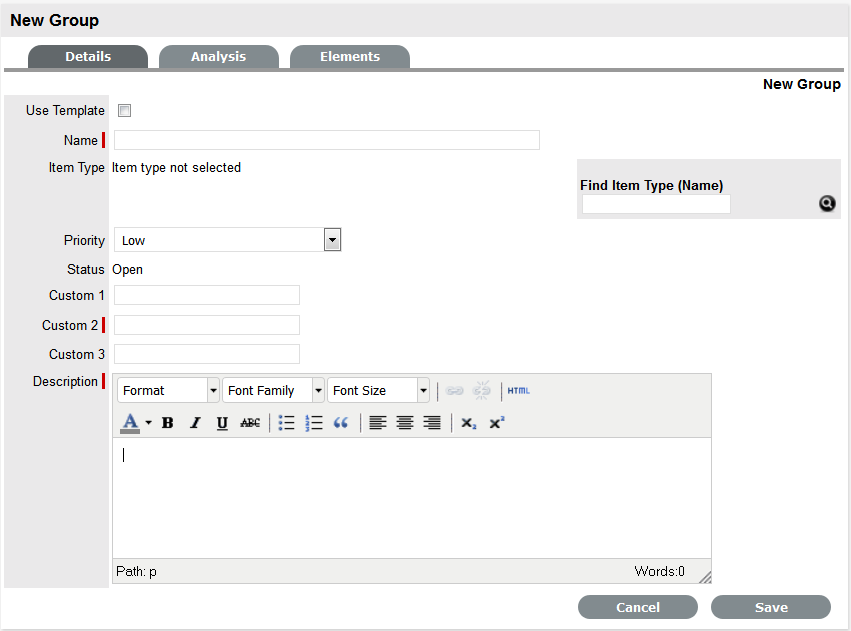
Enter a Name for the Group
Assign an Item Type, if applicable
Assign a Classification, if an Item Type is selected
Assign a Group Priority
The Status is set by default to Open.
Enter a Group Description
Click Save
The screen will default to the Analysis Tab, which allows the User
to Group existing Requests. The information displayed can be adjusted
by using the Filter options.

Check the field next to the relevant Request # to add Requests to the Group
Select Add
The Requests are included in the Elements tab.
Click Done to record
the new Service Request Group.

A Service Group can be created using a Group Template. A Group Template contains a series of tasks in the form of Quick Calls. For more information, see: Group Templates.
Tasks within the Group Template can be created simultaneously or sequentially in the system. If the In Sequence option is used, the first task within the Group Template is created when the Template is selected. When the first task is closed, the next Task within the Template is automatically created and so goes the auto-creation process until all tasks within the Template have been created and closed in sequence.
To create a new Group using a Group Template:
Select Operations>Request Groups
Click
New
The New Group editor is displayed.
Select
the Use Template checkbox
A list of Group Templates is displayed
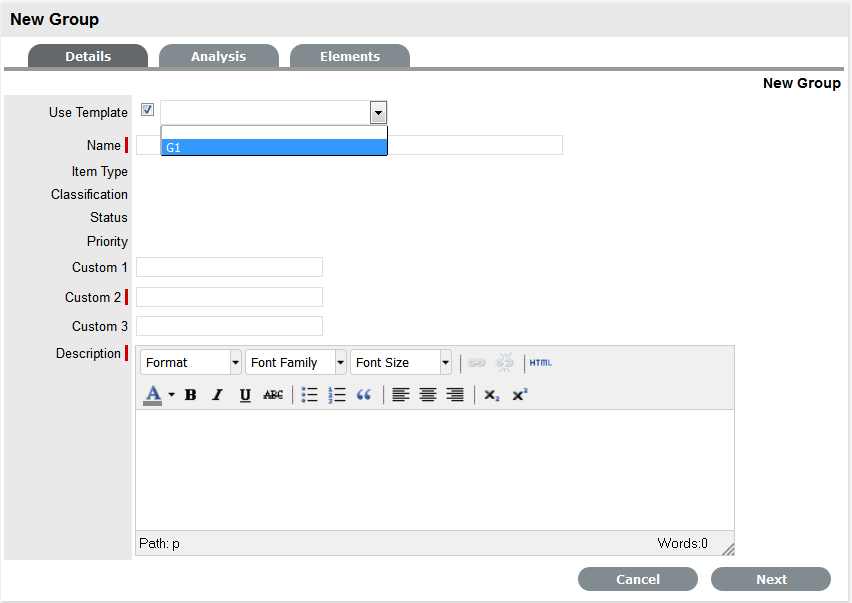
Select
an appropriate Template
The Group details are listed.
Enter
a Name, as unique identifier for this Group
The selected requests for the Group are displayed. These requests are
the Quick Calls assigned to the Group Template.
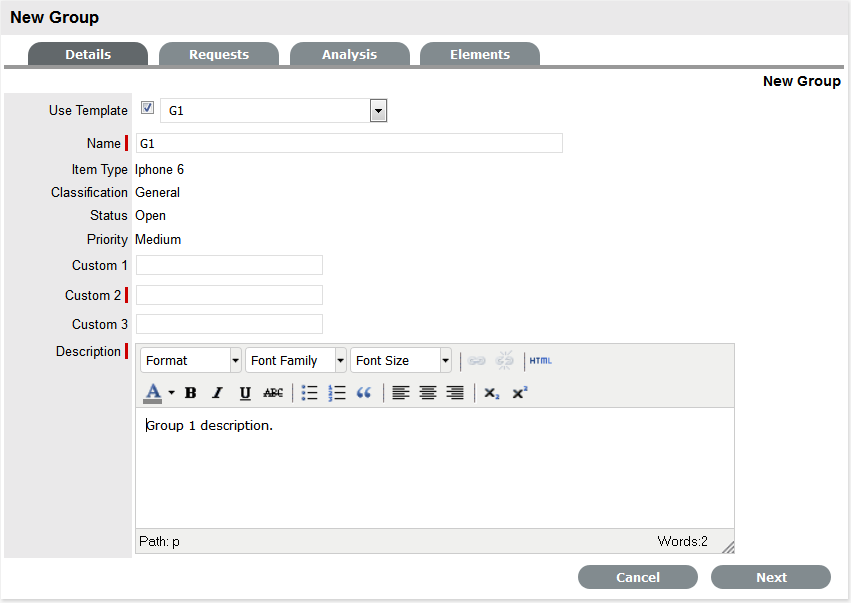
Click
Next
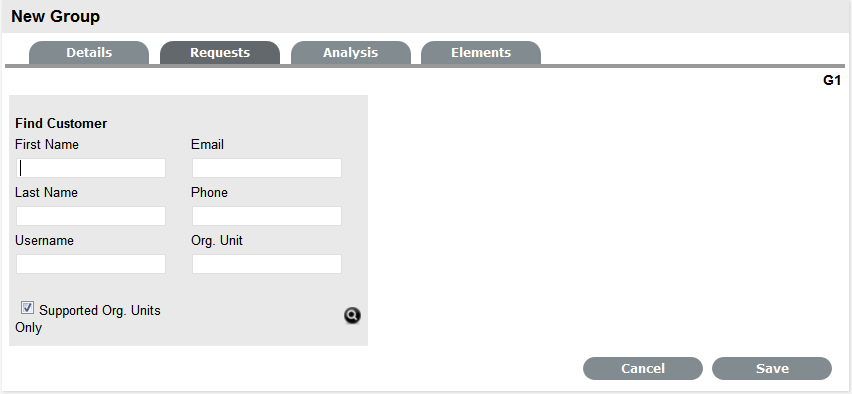
Search
and select the Customer to be associated with the tasks included in
the template
If the Customer details are not in the database and are to be created
as part of the tasks included in the template, assign a default customer
and update the details in the Customer
tab of the Request, when the Customer details exist in the system.
Review
the Selected Requests displayed for the Group
These Requests are the Quick Calls assigned to the Group Template.
To exclude any of the Requests from the newly created Group, untick
the checkbox next to the Template name.
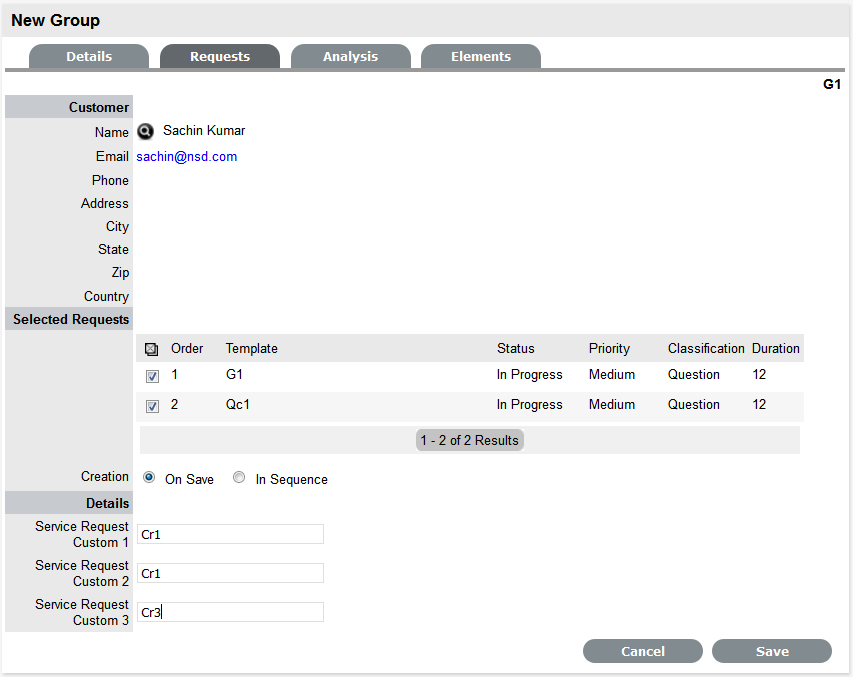
Define the Creation option:
On Save for all the requests to be created when the Request Group is saved
In Sequence for the first request to be created when the Request Group is saved.
Click Save.
The Group is created including all Quick Call Requests. To add or remove
Requests to or from the Group, use the Analysis and Elements tabs
(Covered below).
The type of Group created, whether it be a Service Request, Incident,
Problem or Change, will depend on the Quick Call Tasks assigned to the
Group Template. For example:
If all assigned Tasks are Service Requests, the Group will become a Request Group
If there are Service Request and Incident Quick Call Tasks, the Group will become an Incident Group
If there is at least one Change Quick Call Task, the Group will become a Change Group.
If a Service Request is related to an Incident, Problem or Change Request and the related request in the other Process is closed, the Service Request will be automatically closed. The system views the request hierarchy from low to high as Service Request, Incident, Problem and Change Request, and if a related request of a higher type is closed, all the lesser type requests are automatically closed.
Service Requests can be linked to a Group at the Analysis screen of a Service Request Group. To search for Requests to add to the Group, use the system Filters or the Search option.
The system filter includes the following:
Unassigned Requests |
Description |
|---|---|
Project Requests |
Requests that have been assigned to the Change Group/Project. |
Unassigned Requests |
All Requests that exist in the system and have not been assigned to the Group. |
Potential Requests- Keyword match |
Requests with keywords that match between the Request description and the Group description.
|
All Service Requests (sys) |
Lists all Requests in the system irrespective of Workflow State or User assignment. Note that this option is not visible to Technicians when the privilege to View All Requests is disabled by the Administrator. |
My Service Requests (Active) (sys) |
Displays all Requests in an active Workflow State that are assigned to the logged-in User. |
My Service Requests (All) (sys) |
Displays all Requests, in active and inactive Workflow States, that are assigned to the logged-in User. |
My Teams Service Requests (Active) (sys) |
Displays all Requests in an active Workflow State, allocated to the Teams with which the User is associated. |
My Teams Service Requests (All) (sys) |
Displays all the Requests, in active and inactive Workflow States, allocated to the Teams with which the User is associated. |
Pending Approvals (sys) |
If the User has Manager privileges, this view provides them with a list of Requests that are assigned an Approval stage of the Workflow. |
Service Requests Queue (sys) |
Displays Requests assigned to the System User by default, which Technicians can reassign after viewing. (This is only available if the functionality is enabled for the system and Team.) |
To link Requests within the Service Request Group Analysis tab:
Go to Operations>Request Groups
Select the Service Request Group # link
Move to the Analysis tab
Choose the Filter option
Select
the relevant Requests checkbox on the left

Click the Add button
Click
Done.
The screen defaults to the Groups list.
The Elements tab displays all the Requests that belong to the Service Request Group. Any Request can be removed from the Group from within this screen.
To remove a Request:
Go to Operations > Request Groups
Select the Request Group # link
Move to the Elements tab
Select
the checkbox of the relevant Request

Click the Remove button.
Existing Service Request Groups can be merged within the Request Groups tab, to allow all related Requests within the Groups to be managed as one. To combine Requests Groups:
Go to Operations>Request Groups
Check the fields next to the relevant Group #'s
Click
Merge
The screen defaults to the Details tab for the Merge Group.
Set the Name, Item Type, Classification, Priority and Description that best defines all associated Service Requests
Click
Save.
The History tab records details of the Groups merged to form the new
Group. Click the No. hyperlink to view the details. The Impact tab
records the Type and Number of requests associated with the Group.
A Request Group is automatically closed when all Requests included in the Group are closed.
To close a Group:
Go to Operations>Request Groups
Select the Service Request Group # link
Move
to the Elements tab
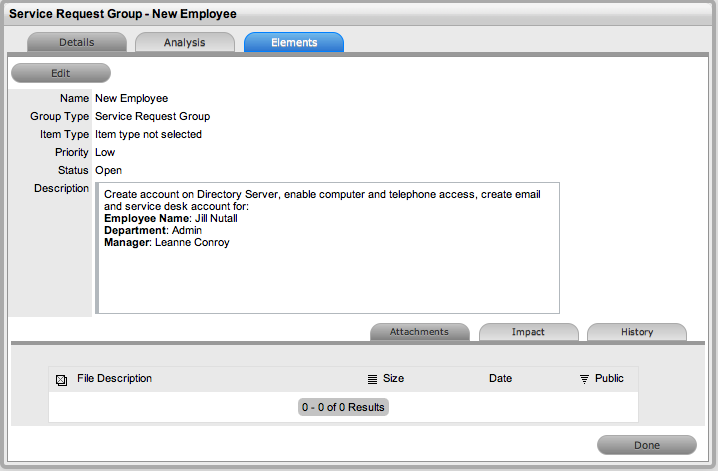
Select a Request # hyperlink
The Summary tab of the Request is displayed.
Click Edit
Within the Related sidebar
check all related Service Requests
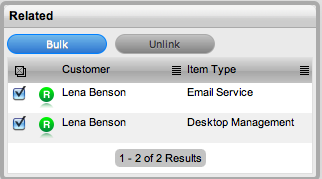
Click the Bulk button
The Bulk Editor screen is displayed
Select the Status of
Closed - Resolved
Or, the relevant Exit State
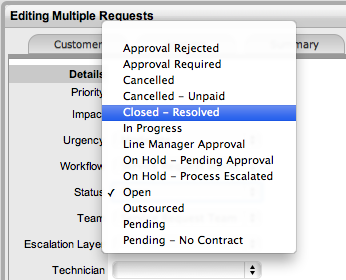
Click Save
Click Save and Done.
The Details tab of the Group now displays a Status of Closed - Resolved.
When a Service Request is duplicated, the new Request is linked to the original Request creating a Request Group. Requests can be unlinked through the Group's Elements tab.